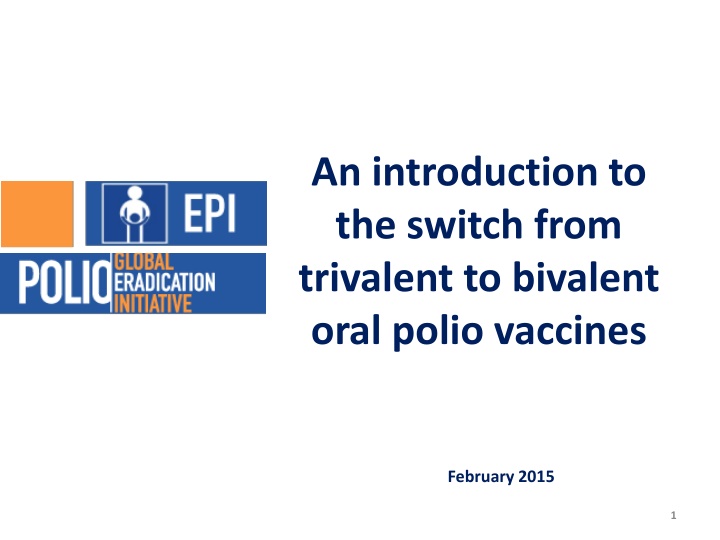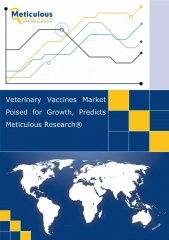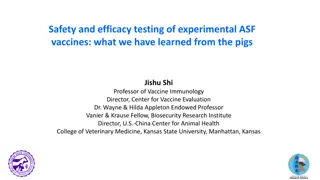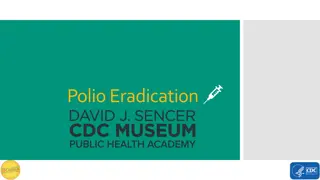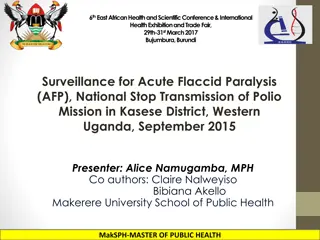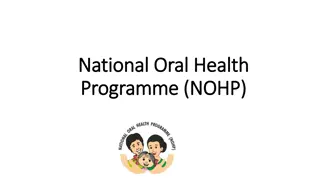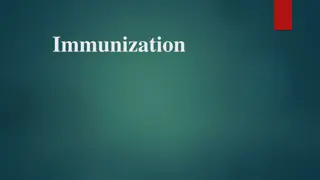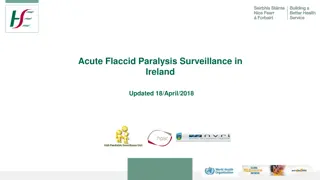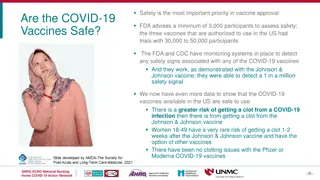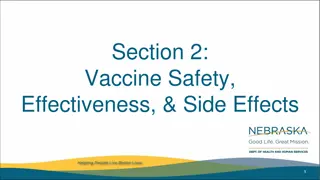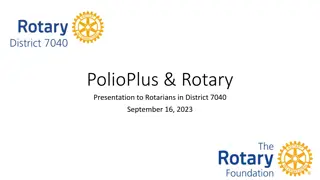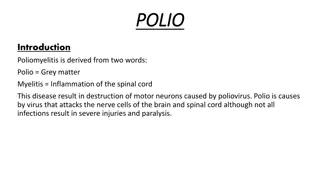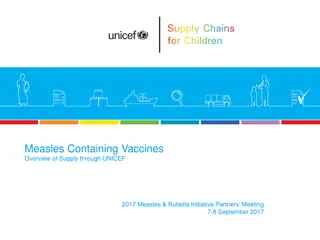Transitioning from Trivalent to Bivalent Oral Polio Vaccines: A Comprehensive Overview
This presentation outlines the rationale for the switch from trivalent to bivalent oral polio vaccines, highlighting the risks associated with the type 2 component of tOPV. It discusses the timeline and programmatic implications of the switch, emphasizing the need to introduce inactivated polio vaccine (IPV) to reduce risks and facilitate faster eradication. The World Health Assembly's resolution on polio eradication and the Endgame Plan milestones are also detailed, offering insights into the global efforts towards eliminating polio.
Download Presentation

Please find below an Image/Link to download the presentation.
The content on the website is provided AS IS for your information and personal use only. It may not be sold, licensed, or shared on other websites without obtaining consent from the author.If you encounter any issues during the download, it is possible that the publisher has removed the file from their server.
You are allowed to download the files provided on this website for personal or commercial use, subject to the condition that they are used lawfully. All files are the property of their respective owners.
The content on the website is provided AS IS for your information and personal use only. It may not be sold, licensed, or shared on other websites without obtaining consent from the author.
E N D
Presentation Transcript
An introduction to the switch from trivalent to bivalent oral polio vaccines February 2015 1
Contents 1. Rationale for OPV withdrawal 2. Timelines for switching from tOPV to bOPV 3. Programmatic implications of the switch 2
Children paralyzed by polio 400 Type 2 polio Polio cases (thousands) 300 eradicated (WPV) 200 100 0 1992 1997 1985 1986 1987 1988 1989 1990 1991 1993 1994 1995 1996 1998 1999 2000 2001 2002 2003 2004 2005 2006 2007 2008 2009 2010 2011 2012 3
Vaccine-derived polio outbreaks (circulating VDPVs) 2000-2013 Type 1 (79 cases) Type 2 (478 cases) Type 3 (9 cases) Type 1 Type 2 Type 3 4
World Health Assembly resolution 65.5 Declares polio eradication a programmatic emergency for global public health... endgame plan urges the Director General to rapidly finalize a polio switch from trivalent to bivalent OPV for all routine immunization programmes and inform Member States of the potential timing of a (May 2012)
Coming dates for the Endgame Plan May 2015 World Health Assembly to consider resolution on the switch December 2015 At least 1 dose of IPV introduced into routine immunization programmes in all countries April 2016 Withdraw type 2 OPV globally 2020? After all wild polioviruses have been fully eradicated, withdraw all OPVs 6
Rationale for switching from trivalent OPV to bivalent OPV Currently, the risks associated with the type 2 component of tOPV outweigh the benefits Since 1999, type 2 wild poliovirus has not been detected The type 2 component of tOPV: Causes more than 90% of vaccine-derived polio viruses (VDPVs) Causes approx. 40% of vaccine-associated paralytic polio (VAPP) cases Interferes with the immune response to poliovirus types 1 and 3 in tOPV IPV introduction will help to: Reduce risks associated with the withdrawal of OPV type 2 Facilitate interruption of transmission with the use of monovalent OPV type 2 in the case of outbreaks Hasten eradication by boosting immunity to poliovirus types 1 and 3 7
Contents 1. Rationale for OPV withdrawal 2. Timelines for switching from tOPV to bOPV 3. Programmatic implications of the switch 8
Milestones towards the switch May 2015, World Health Assembly (WHA): Discussion on progress and timelines towards OPV2 withdrawal in April 2016 As proposed by the WHO Executive Board in January 2015, the WHA may consider a resolution calling on member states to implement the switch October 2015, Strategic Advisory Group of Experts (SAGE): SAGE will review and decide on final risk assessment data to determine if the trigger for OPV2 withdrawal has been met Trigger for OPV2 withdrawal: global absence of cVDPV2s that are known to have been circulating for more than 6 months ("persistent" cVDPV2s) If SAGE confirms that the trigger has been met, GPEI will announce the 2016 switch dates Once the decision to proceed with the switch in 2016 is announced, it is irrevocable. The switch will not be postponed after that date However, if the trigger condition is not met in September 2015, the switch will be reassessed and may be postponed until 2017 9
General steps for the switch World Health Assembly in May to consider: IPV is introduced in all countries by end 2015 bOPV is licensed for routine immunization Surveillance and response capacity are implemented for WPV2 detection, and a type 2 monovalent OPV stockpile set up Phase 1 containment activities are completed, with appropriate handling of residual type 2 materials WPV2 global eradication is verified Readiness criteria SAGE in October to consider: Trigger Absence of all persistent cVDPV2s globally Replace tOPV with bOPV globally in a 2-week span No use of tOPV after this period Synchronized switch 10
Switch window example: April 2016 in a country e.g. National Switch Day: stop tOPV use e.g. National Validation Day: all tOPV disposed Global Validation Day disposal and validation 2-week window week 1 week 2 week 3 week 4 Global validation 2-week window Global switch 2-week window The country selects a National Switch Day from this window 11
Global synchronization and planning To minimize the risk of any type 2 cVDPV re-emergence or outbreaks from the use of tOPV, the switch will need to take place everywhere worldwide within a 2-week period. Implications for tOPV supply planning: tOPV stocks needed for national routine immunization only until March 2016 Countries should coordinate with their relevant supplier to plan around the switch The last in-country distribution of tOPV should take place 4 weeks before the switch date Important to avoid tOPV stock-outs in the weeks before the switch Countries should enhance stock monitoring and management capacity starting in 2015 Implications for bOPV: 3-6 months of supplies of bOPV should be planned for and received in countries from January 2016 onwards New bOPV stocks should be kept at central level, stored separately until distribution Supply may be distributed to vaccination points starting 2 weeks before the national switch date Countries should not switch before the global switch window. 12
Contents 1. Rationale for OPV withdrawal 2. Timelines for switching from tOPV to bOPV 3. Programmatic implications of the switch 13
Mitigating risks before the switch High population immunity is necessary for successful OPV cessation, to help reduce the risks of cVDPV emergence Higher risk countries will conduct tOPV SIAs in Q4 2015 and Q1 2016, at national and/or subnational level The plan for risk mitigation SIAs was discussed and agreed by SAGE in October 2014.
Principles of tOPV withdrawal Requires a complete global replacement of tOPV by bOPV Overall process steps: switch Switch: tOPV is removed from the (private and public sector) cold chain and replaced with bOPV on the National Switch Date Recall: tOPV is transported to collection points Dispose: tOPV stocks are safely disposed Validate: national and international monitors supervise the process and validate the complete absence of tOPV stock on National Validation Day (2 weeks after National Switch Date) recall dispose validate Manufacturers will not supply any more tOPV starting a short period before the switch. 15
Country level considerations Planning and management Now: Forecast quantities for supply and procurement of bOPV and tOPV Coordinate with national committees and private sector, for both routine immunization and supplemental campaigns Develop a national operational plan by mid 2015 Regulatory Initiate process for national licensure of bOPV licensure (in countries that require it) Note that bOPV is the same as tOPV for volume, heat sensitivity, VVM, and wastage Implementation, monitoring, logistics, communication Establish a switch support team to implement the plan Adapt workplans, communication and training materials to local context and language Update data tools Update information systems to monitor activities at all levels 16
Preparation underway at a global level Involving vaccine manufacturers and national regulatory authorities on bOPV licensure and supply. Consulting on presentations and labelling Developing procurement and distribution strategies to minimize stocks of tOPV while avoiding stockouts prior to the switch date, including with self-procuring countries Developing and disseminating Switch protocol templates, workplans, communication and training materials Seeking endorsement of the switch by WHO member states through an expected World Health Assembly discussion in May 2015 Establishing monitoring systems at all levels to track progress 17
Next steps for switch planning and communications Switch implementation working group (under the IMG) Coordinating planning, preparations, and technical assistance. Communications and training Disseminating information and hosting webinars from Q1 2015 to inform planning and developing materials for health worker training The Switch Protocol: an implementation guide The Protocol will be published in early 2015 Regional briefings/trainings will help build awareness and capacity Liaison with UNICEF country offices and relevant manufacturers for self- procuring countries vital to implementation and supply strategies Countries will be responsible for monitoring stock levels and adjusting the frequency and/or quantities of tOPV deliveries to minimize risk of excess stocks and stock-outs at country level. Country pilot exercises will help refine preparations, guidance, and information collection systems 18
COMING SOON! OPV technical background, communications and training materials: http://www.who.int/immunization/diseases/poliomyelitis /endgame_objective2/en/
THANK YOU For more information: http://www.who.int/immunization/diseases/poliomyelitis/endgame_objective2/en/ 20
